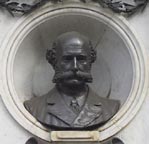 Sir Joseph Bazalgette (1819-1891) has been described as "a central figure in the heroic epoch of British engineering" (Ellis 216). Like his friend Brunel, Bazalgette was of French descent, the grandson of an emigré tailor who had made his fortune in Mayfair. Himself the son of a naval officer, he learnt his trade under Sir John MacNeill and at the Institution of Civil Engineers, and set up his own practice near Parliament Square in 1842. In 1849, after getting over a period of ill health, he was appointed assistant surveyor to the second metropolitan commission for sewers in London. Sewage was now a major problem: the ancient cesspool system of early nineteenth-century London was breaking down under pressure from the massively expanding urban population, and particularly from the new fashion for water-closets. With the celebrated civil engineers Robert Stephenson and Isambard Kingdom Brunel among his referees, Bazalgette was formally appointed to the newly established Metropolitan Board of Works in 1856 to provide an alternative.
Sir Joseph Bazalgette (1819-1891) has been described as "a central figure in the heroic epoch of British engineering" (Ellis 216). Like his friend Brunel, Bazalgette was of French descent, the grandson of an emigré tailor who had made his fortune in Mayfair. Himself the son of a naval officer, he learnt his trade under Sir John MacNeill and at the Institution of Civil Engineers, and set up his own practice near Parliament Square in 1842. In 1849, after getting over a period of ill health, he was appointed assistant surveyor to the second metropolitan commission for sewers in London. Sewage was now a major problem: the ancient cesspool system of early nineteenth-century London was breaking down under pressure from the massively expanding urban population, and particularly from the new fashion for water-closets. With the celebrated civil engineers Robert Stephenson and Isambard Kingdom Brunel among his referees, Bazalgette was formally appointed to the newly established Metropolitan Board of Works in 1856 to provide an alternative.
The new chief engineer drew up his plans quickly, but his new comprehensive sewerage system, described in its early stages as "the most extensive and wonderful work of modern times" (by the Observer of 14 April 1861, qtd. in Halliday 135), has lasted into our own day. Bazalgette's most easily identifiable legacy, though, was the Thames Embankment, where his memorial can now be seen on the wall of the Victoria stretch. The Embankment was designed to house the large sewers running parallel to each side of the Thames, carrying the contents of house drains and sewers to pumping stations and treatment works. On its north side, the sewer ran along the Thames to the famous Abbey Mills pumping station in West Ham. Had it not been for the Victoria Embankment on this side (running from Westminster to Blackfriars), Bazalgette would need to have routed the sewer under the Strand, Fleet Street and Ludgate Hill, causing unimaginable chaos. The tremendous change made by reclaiming 52 acres of riverside ground in the capital can be glimpsed by visiting Buckingham Gate. This is the watergate to the Duke of Buckingham's York House, now well back off the river and marooned on dry land in the Embankment Gardens.
The Embankment nicely brings together three of Bazalgette's great achievements: public health engineering, thoroughfare engineering, and riverside work. In addition to the Embankment he designed some of central London's important thoroughfares, including Shaftesbury Avenue and Charing Cross Road, and also designed or overhauled the Thames bridges, for example, the Albert Bridge. Has any other single individual done more to change the face of London (consider the work of John Nash), or the health of Londoners (consider the work of Joseph Lister and others in the medical profession)? Bazalgette contributed to other cities too, for example he designed the Broadway Bridge over the Medway at Maidstone. He also advised on numerous projects at home and abroad.
Bazalgette and his wife Maria had ten children, and their family home was in St John's Wood. He was knighted in 1874. In 1889 he retired to Wimbledon, where he is buried in the churchyard of St Mary's Church (was another of the many churches designed by Sir George Gilbert Scott). Roger Ellis reports that the famous engineer was "small, reserved, phlegmatic" (216); but, according to Cassell's Saturday Journal of 30 August 1890, "his face, with its prominent acquiline [sic] nose, its keen grey eyes, and its grey whiskers and black eyebrows, gives you the impression of a man of exceptional power" (qtd. in Smith). Did George Blackall Simonds capture this "power" in his Embankment memorial, or only the reserve?
Related Material
Sources
Ellis, Roger. Who's Who in Victorian Britain. London: Shepheard-Walwyn, 1997.
Halliday, Stephen. Making the Metropolis: Creators of Victorian London. Derby: Breedon Books, 2003.
Smith, Denis. "Bazalgette, Sir Joseph William (1819-1891, Civil Engineer)." The Oxford Dictionary of National Biography. Viewed 23 August 2007.
Weinreb, Ben and Christopher Hibbert. The London Encyclopaedia. London: Macmillan, rev. ed. 1992.
Last modified 21 January 2011